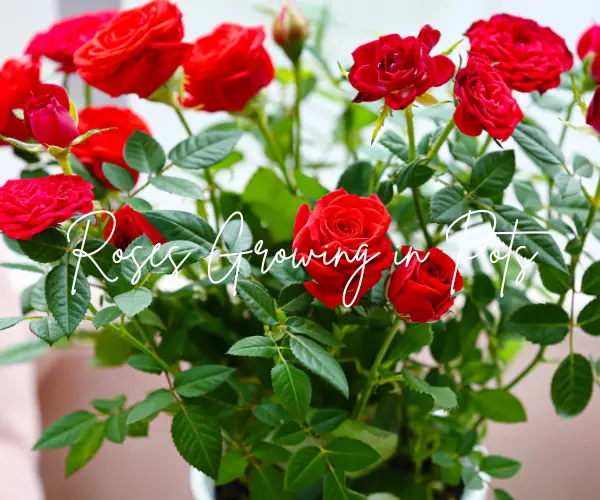For those with limited outdoor space or living in apartments and condos, the idea of growing beautiful roses may seem like a far-fetched dream.
However, with the right knowledge and care, it’s entirely possible to cultivate thriving rose plants in containers.
This thorough post will cover all you need to know to successfully grow roses in pots, including if it is feasible to grow roses in pots, which types are best, and much more.

Can Roses Be Planted in Pots
The Possibility of Potted Roses
While roses are often associated with sprawling gardens and meticulously manicured landscapes, many varieties adapt surprisingly well to container living.
The key lies in selecting the appropriate rose type, providing the right growing conditions, and employing proper care techniques. With the correct approach, potted roses can flourish and add a touch of elegance to any outdoor space, no matter how small.
Choosing the Right Rose Varieties for Containers
Not all roses are created equal when it comes to container gardening. Some varieties are better suited to the confined space and unique growing conditions of pots. Here are some of the best options to consider:
1). Miniature Roses: As the name suggests, miniature roses are compact plants that grow to a height of 1-2 feet, making them perfect for containers. They come in a wide range of colors and bloom prolifically throughout the growing season.
2). Patio Roses: Patio roses, also known as polyantha roses, are bred specifically for container growing. They are low-maintenance, disease-resistant, and produce an abundance of small, clustered blooms.
3). Floribunda Roses: Floribunda roses are a cross between polyantha and hybrid tea roses, offering a balance of compact growth and large, showy flowers. They are an excellent choice for containers and can thrive in partial shade.
4). Shrub Roses: While some shrub roses can grow quite large, several dwarf varieties make excellent container plants. These low-maintenance roses are known for their hardiness and disease resistance.
5). Climbing Roses: While not the most obvious choice for containers, certain climbing rose varieties can be trained to grow upright or on a trellis, adding vertical interest to your potted garden.
Choosing the Right Container
Once you’ve selected your desired rose variety, the next step is to choose an appropriate container. Here are some factors to consider:
Container Size: Roses have extensive root systems, so it’s essential to provide a container that’s large enough to accommodate their growth. As a general rule, choose a pot that’s at least 18–24 inches wide and deep for miniature and patio roses and 24-36 inches for larger varieties like floribundas and shrub roses.
Container Material: Terra cotta, plastic, and wood are all suitable materials for rose containers. Terra cotta is porous and allows for good air circulation, but it can dry out quickly. Plastic and wood containers are more moisture-retentive but may need better drainage holes.
Drainage: Proper drainage is crucial for rose health. Choose containers with ample drainage holes or drill additional ones to prevent waterlogged soil, which can lead to root rot.
Soil and Fertilizer
Roses thrive in well-draining, nutrient-rich soil. When planting in containers, it’s essential to use a high-quality potting mix specifically formulated for roses or a general-purpose potting mix amended with compost or aged manure.
Additionally, regular fertilization is key to providing the nutrients necessary for robust growth and abundant blooms. Choose a balanced, slow-release fertilizer formulated for roses, and follow the manufacturer’s instructions for application rates and frequency.
Sunlight and Water Requirements
Roses are sun-loving plants, requiring at least 6 hours of direct sunlight per day for optimal growth and flowering. However, some varieties, like certain floribundas and climbers, can tolerate partial shade.
Proper watering is also crucial for potted roses. The soil should be consistently moist but never waterlogged. Check the soil moisture regularly and water when the top inch or two of soil feels dry. Avoid wetting the foliage, as this can promote fungal diseases.
Pruning and Maintenance
Regular pruning is essential for maintaining the health and shape of your potted roses. Prune in late winter or early spring, removing any dead, damaged, or crossing branches. For repeat-blooming varieties, prune spent flowers to encourage new growth and blooms.
Additionally, watch for common rose pests and diseases, such as aphids, spider mites, black spots, and powdery mildew.
Proper cultural practices, like avoiding overhead watering and ensuring good air circulation, can help prevent many issues. If problems arise, address them promptly with appropriate organic or chemical treatments.
Overwintering Potted Roses
In colder climates, potted roses may require special care during the winter. Here are a few tips for overwintering:
1. Move containers to a sheltered location, such as a garage or shed, where temperatures remain above freezing.
2. If leaving roses outside, insulate the containers by wrapping them in burlap or surrounding them with mulch or leaves.
3. Reduce watering but don’t allow the soil to dry out completely.
4. Prune back canes to about 6–12 inches from the ground in late fall.
With the right variety selection, proper container size, and attentive care, growing roses in pots can be a rewarding and visually stunning endeavor.
Whether you have a spacious balcony, a cozy patio, or a small courtyard, potted roses can add a touch of elegance and beauty to any outdoor living space.




